The effect of perceived benefits and perceived risks on intention to shop apparel online by white - collar women in Viet Nam
ABSTRACT
Online apparel shopping has become more and more popular and has attracted many consumers. This research
aims to study how these perceived benefits and perceived risks influenced Internet users on buying apparel online. A
survey of 298 white-collar women was carried out to identify the benefits and risks when buying apparel online.
Five dimensions of perceived benefits (i.e. convenience shopping, abundance and liking product, competitive price,
enjoyment, and comfortable shopping) and three dimensions of perceived risks (i.e. financial risk, product risk, and
time risk) were ascertained by exploratory factor analysis. The correlation between these benefits and risks with
online purchasin g intention was explored by multiple regression tests. The result demonstrates that consumers
perceive benefits more than risks in online apparel shopping. While ‘comfortable shopping’ has the strongest effect
on respondents’ intention, ‘competitive price’ has the lowest effect. Among the risks, product risk is of highest
concern, followed by financial risk and time risk. The result also shows that middle-age white-collar women of 31 to
40 years old have the intention to shop apparel online higher than other groups.
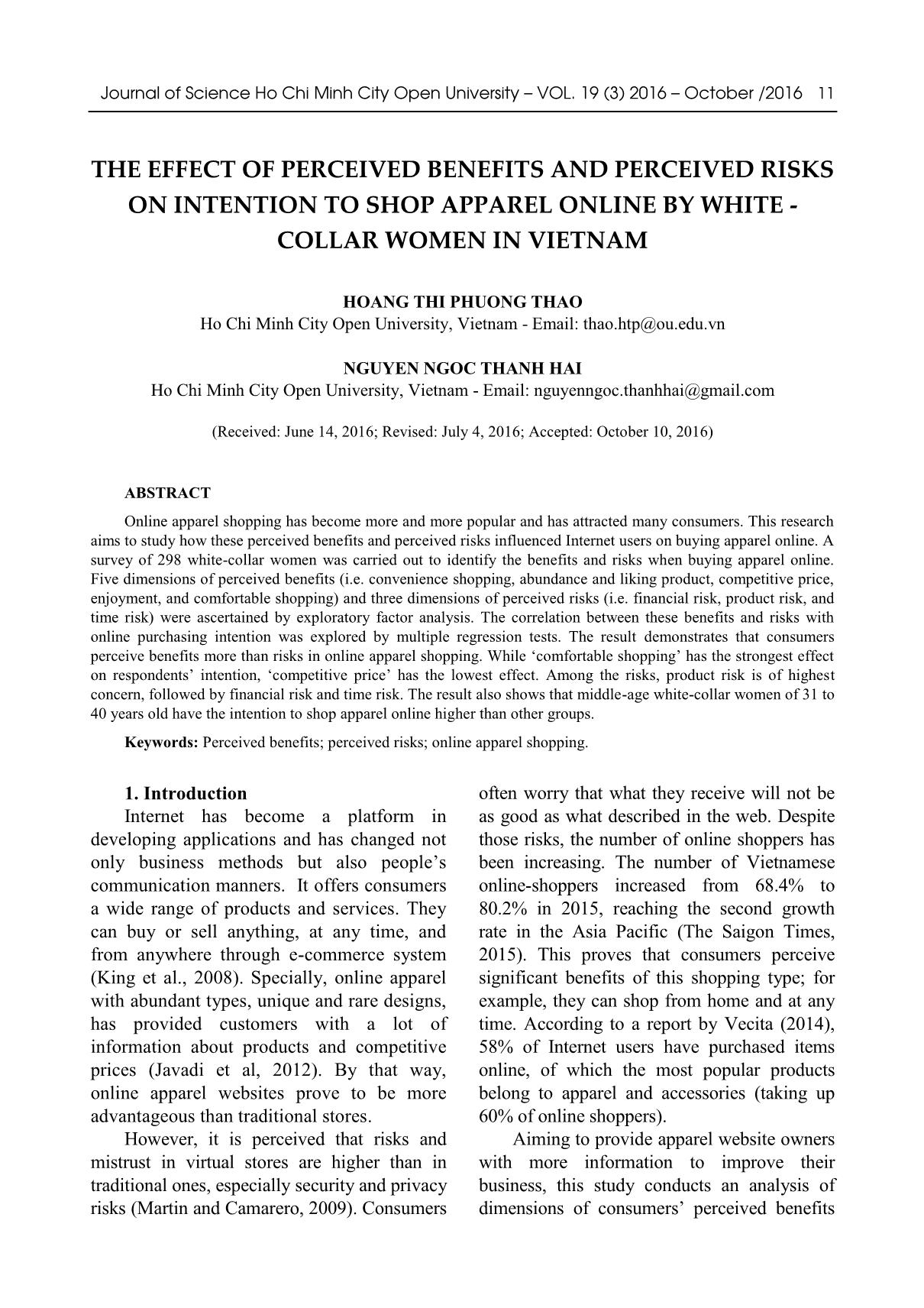
Trang 1
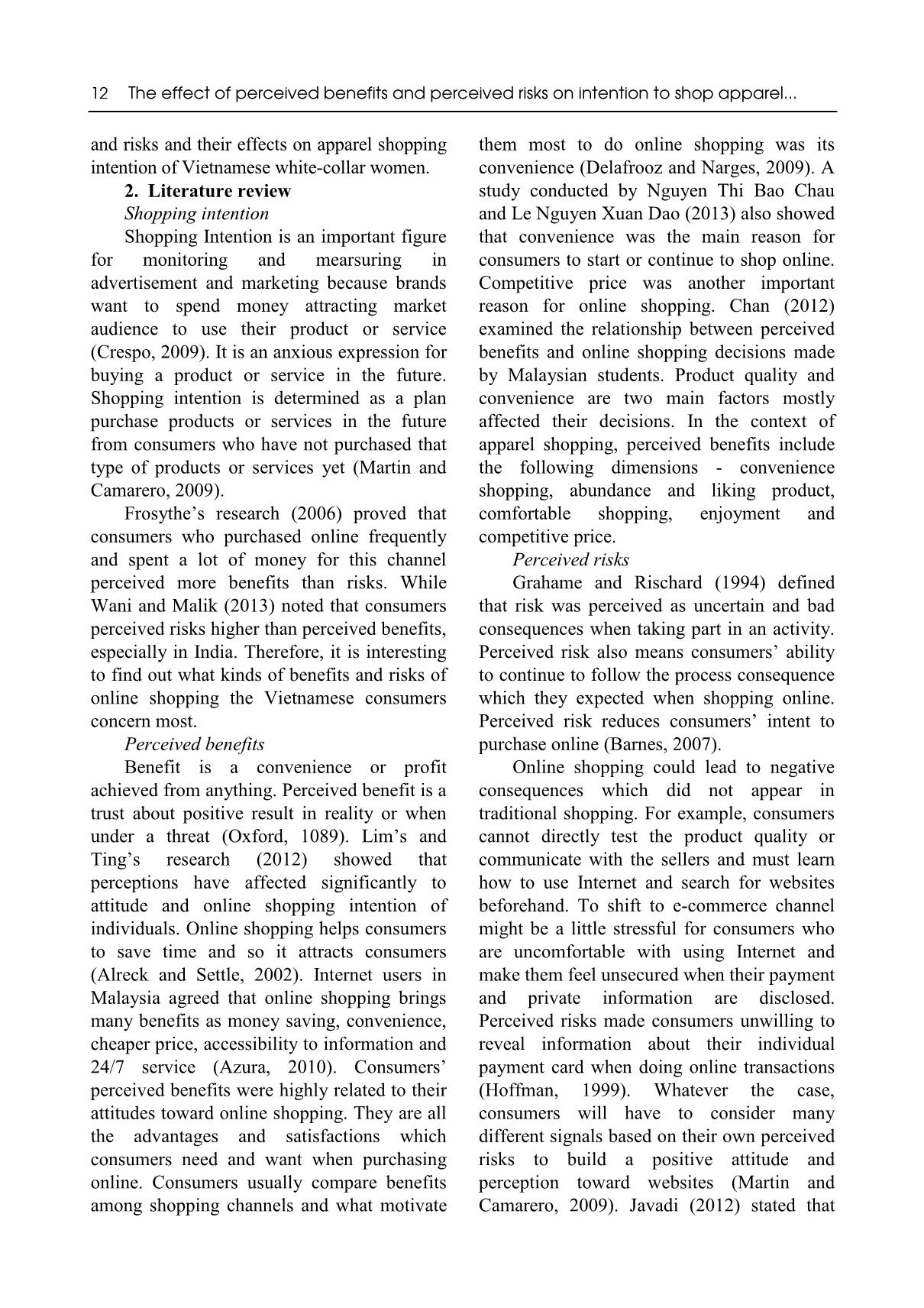
Trang 2
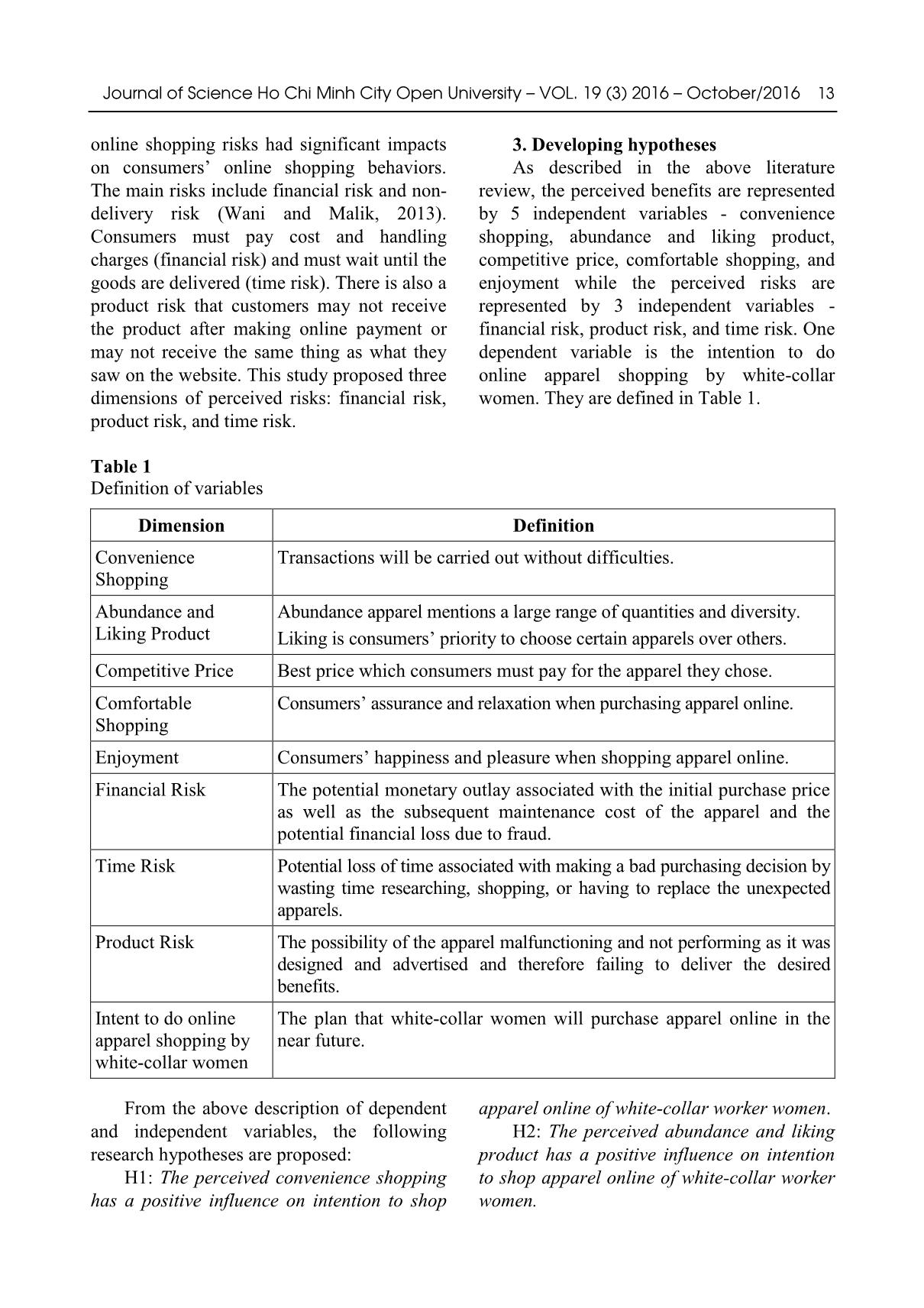
Trang 3
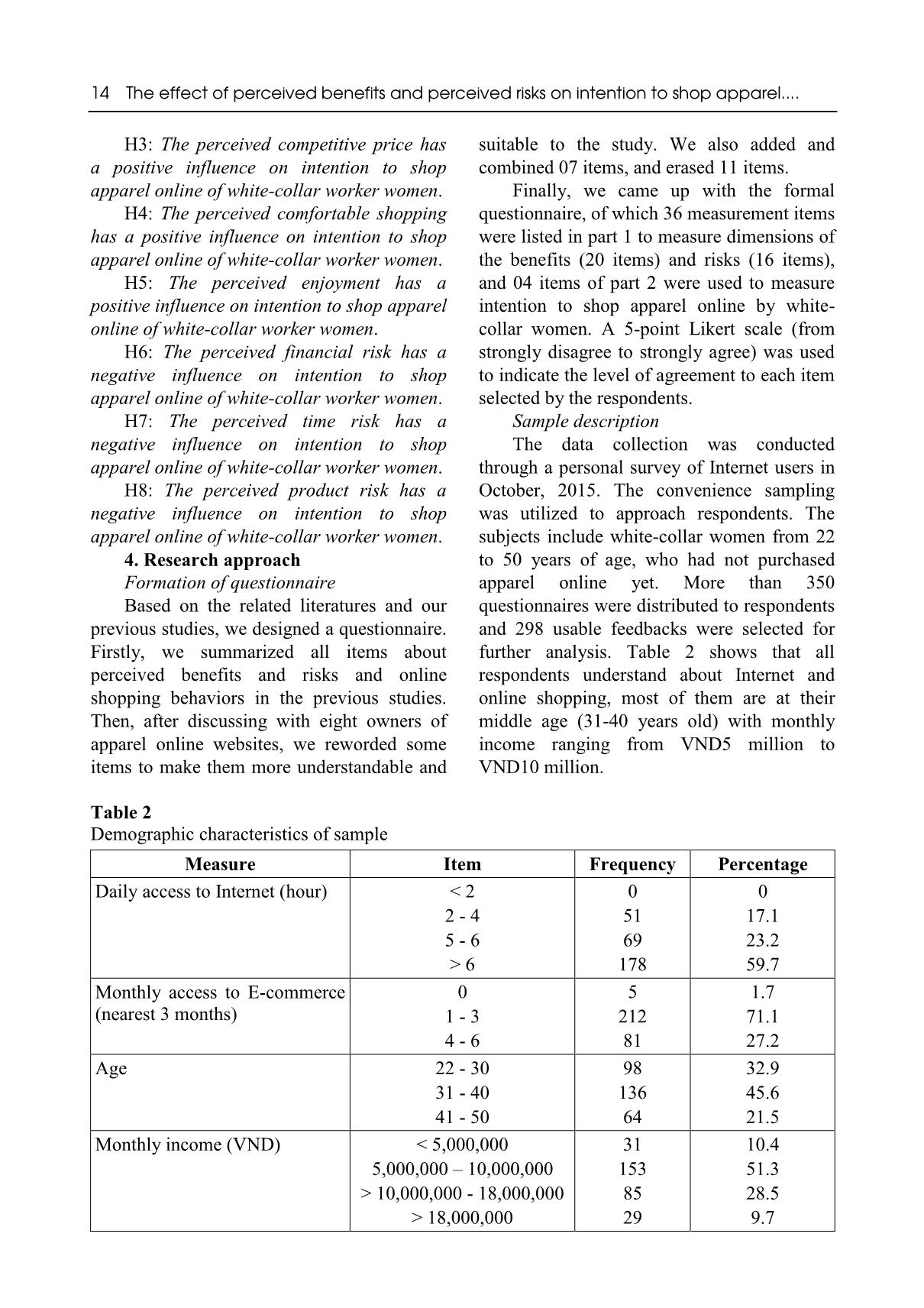
Trang 4
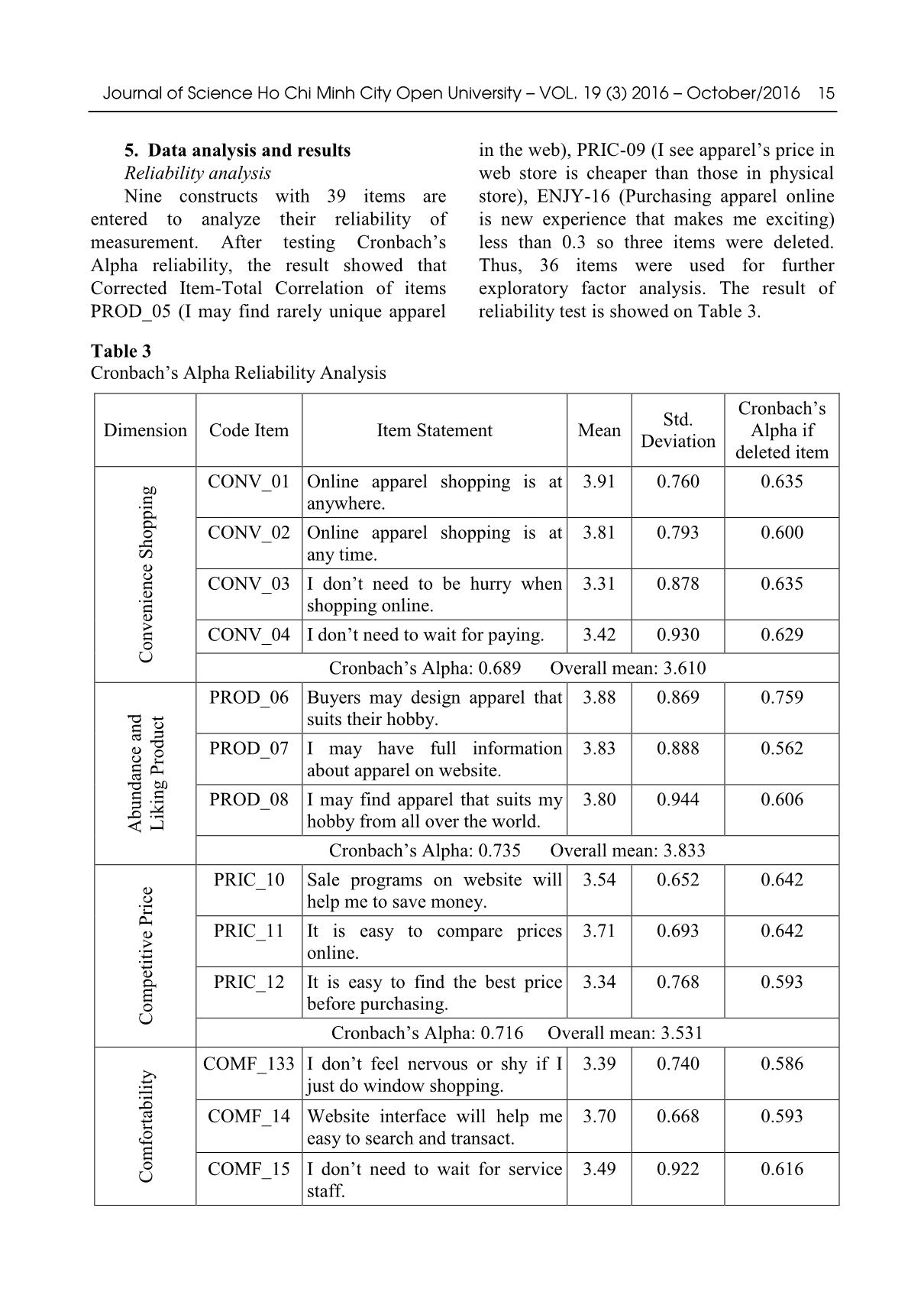
Trang 5
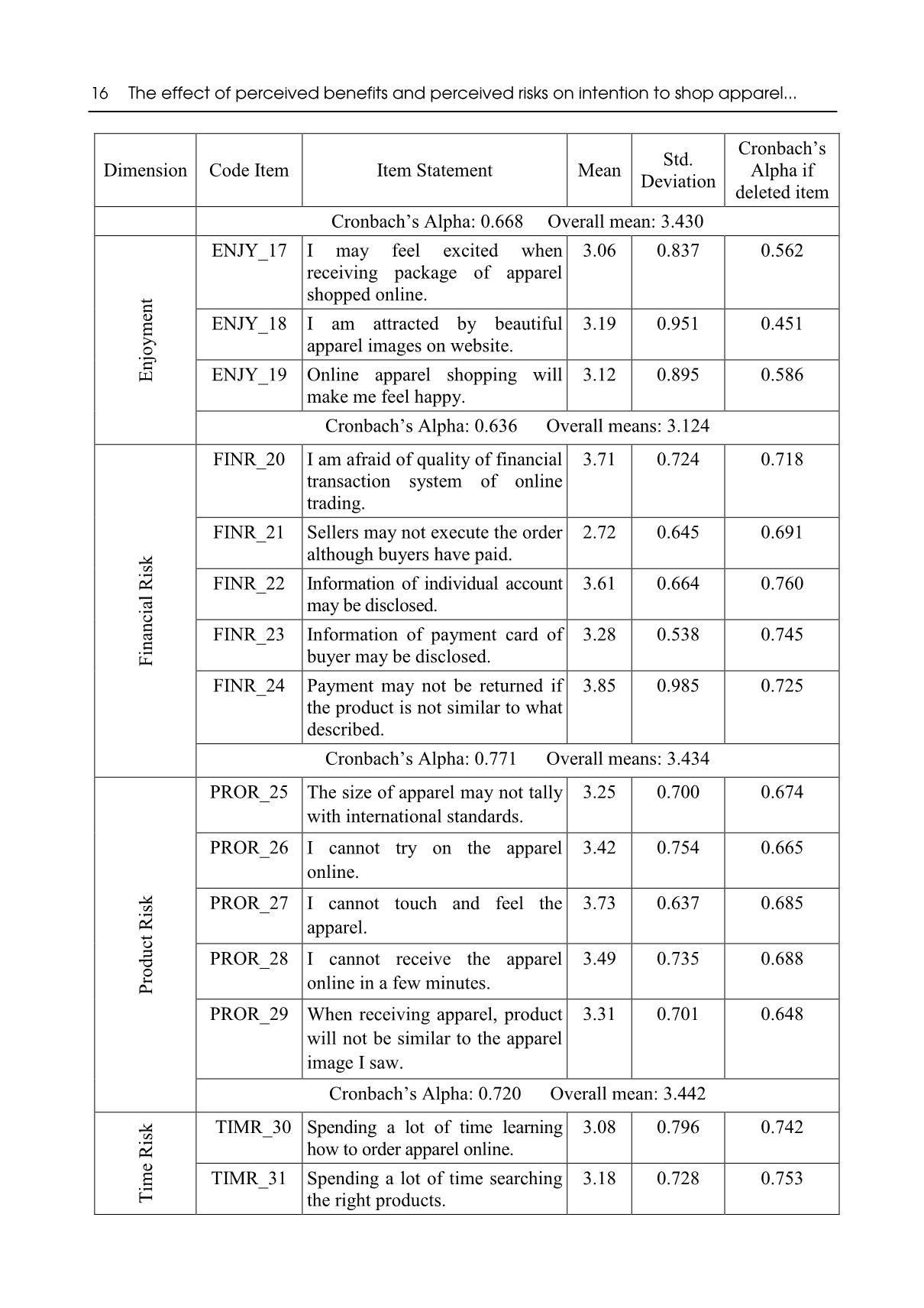
Trang 6
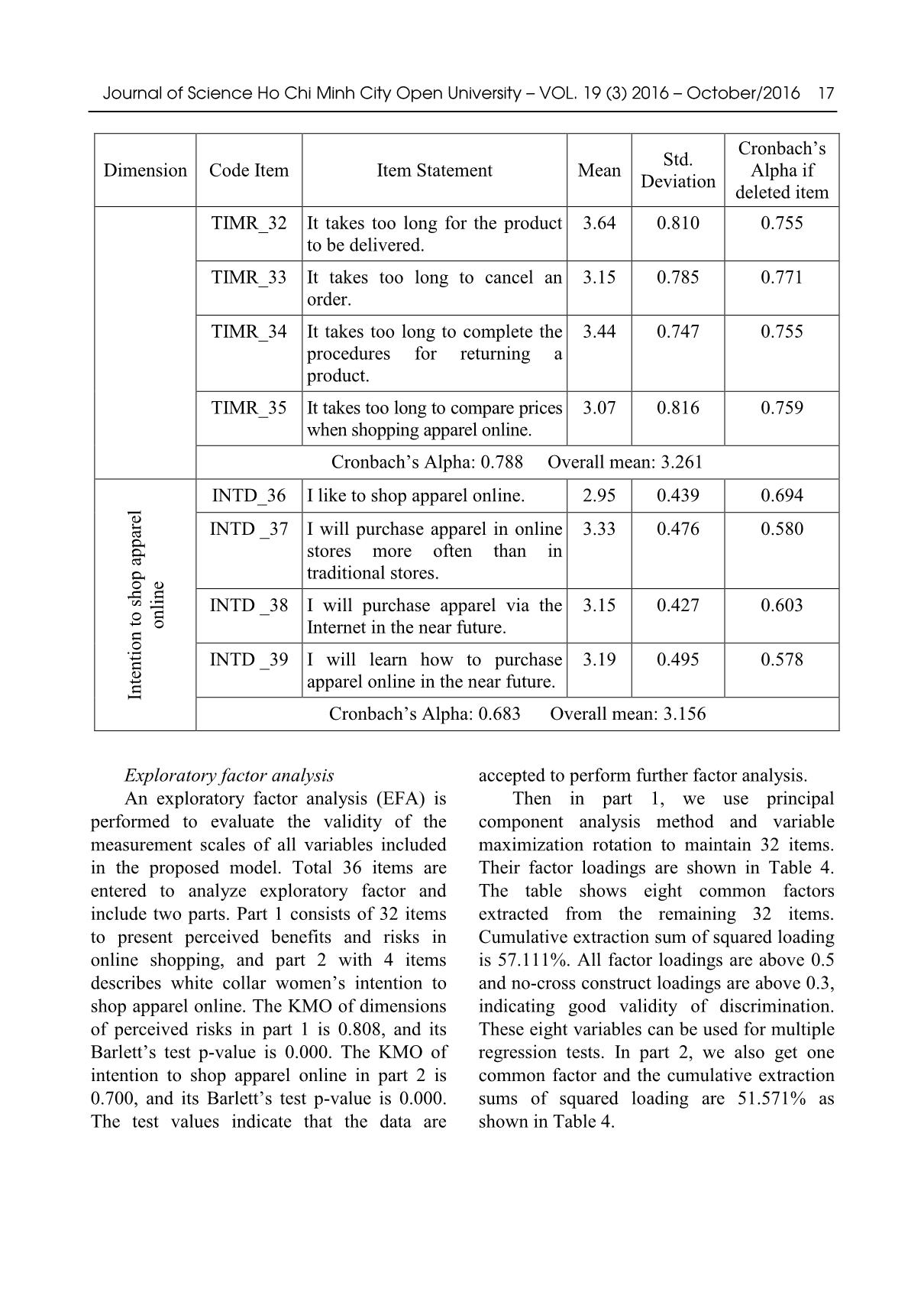
Trang 7
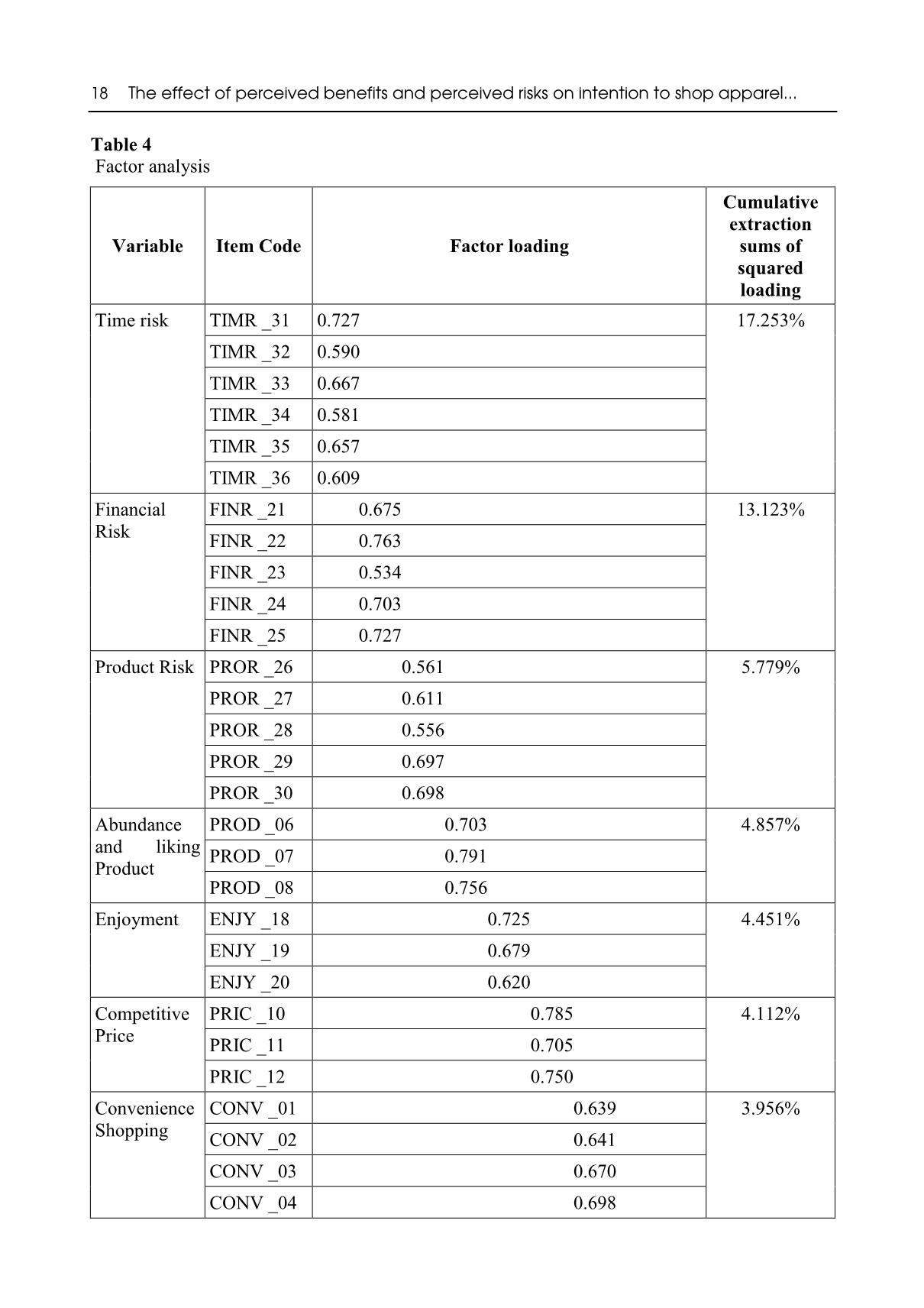
Trang 8
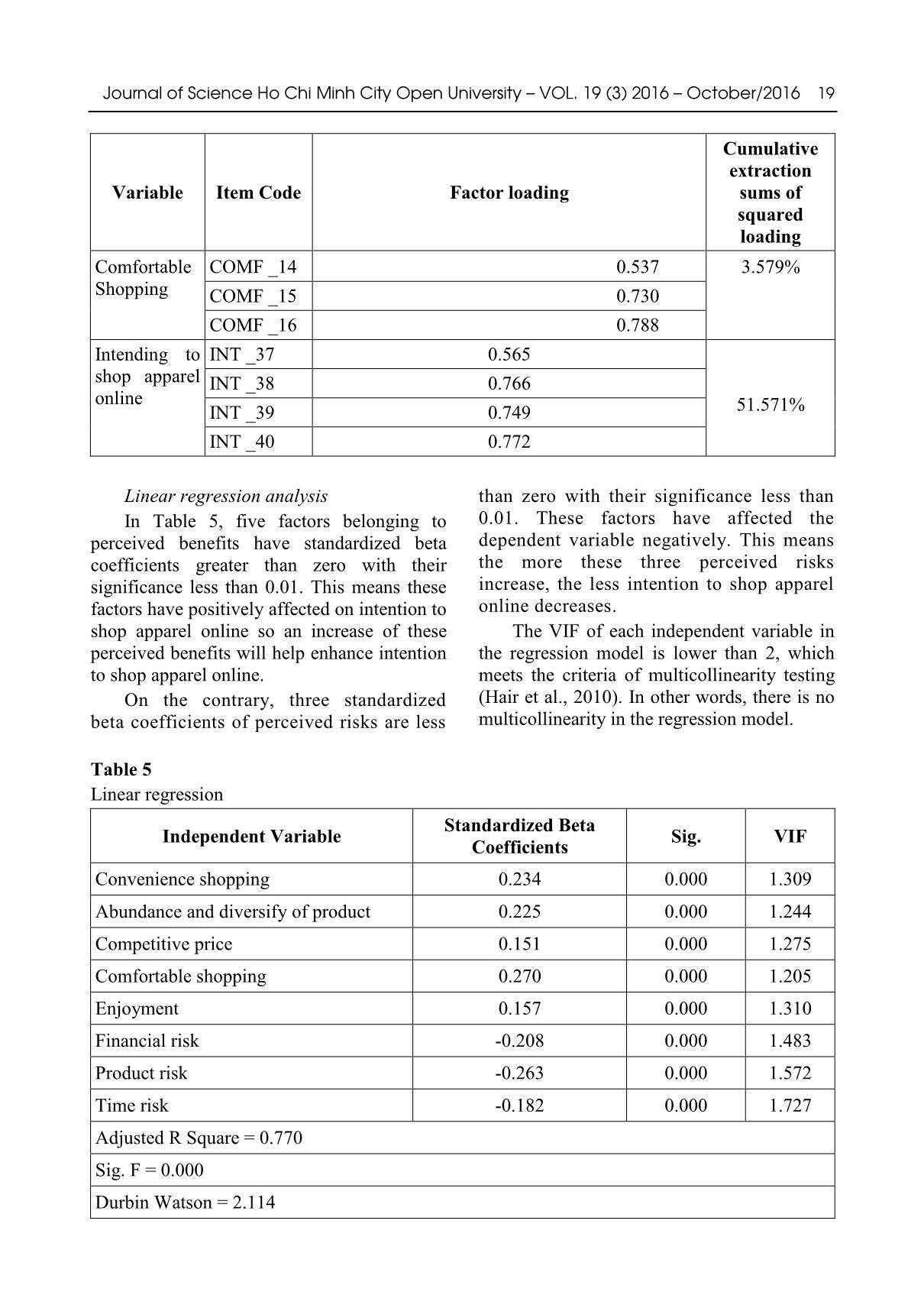
Trang 9
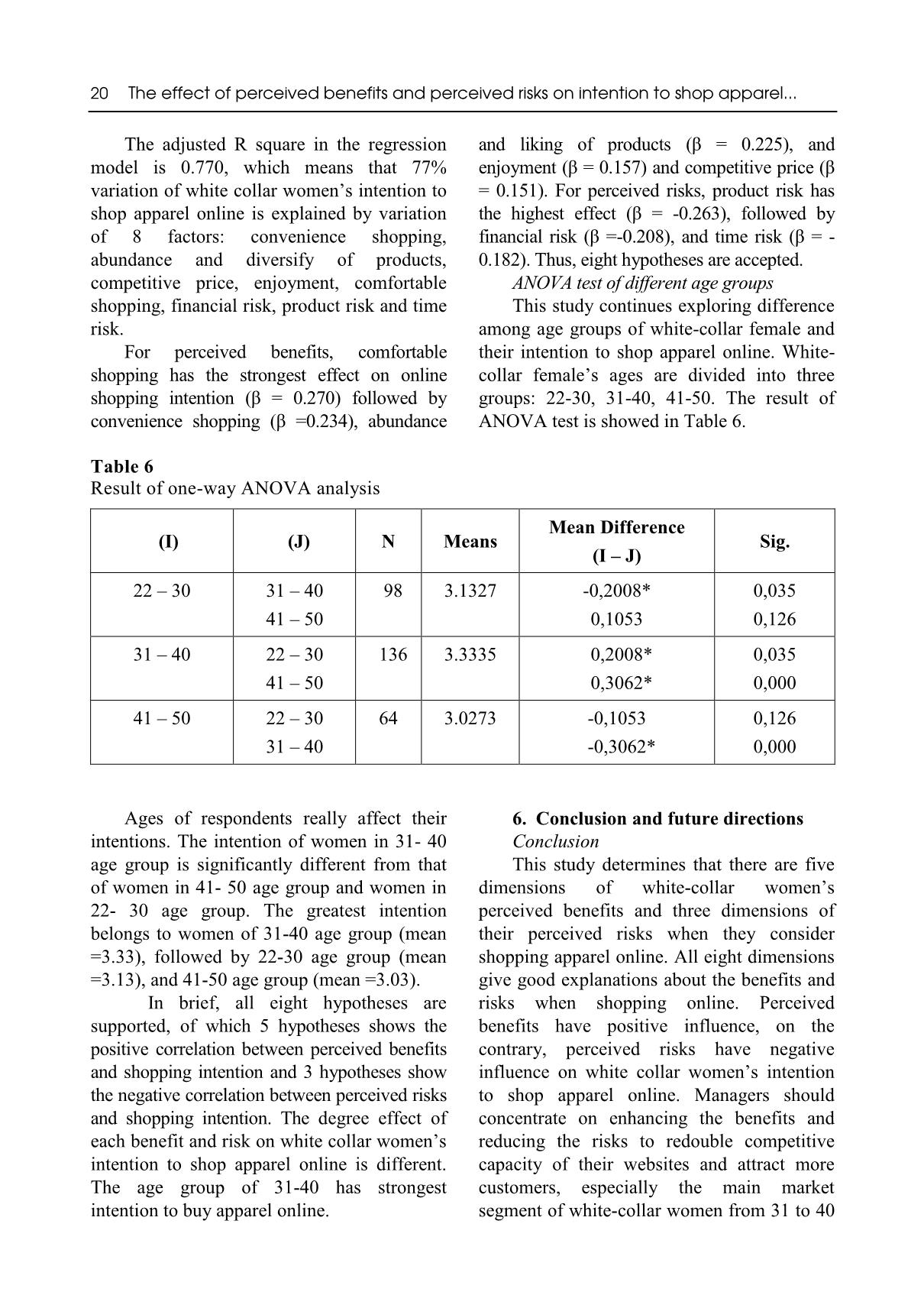
Trang 10
Tải về để xem bản đầy đủ
Tóm tắt nội dung tài liệu: The effect of perceived benefits and perceived risks on intention to shop apparel online by white - collar women in Viet Nam
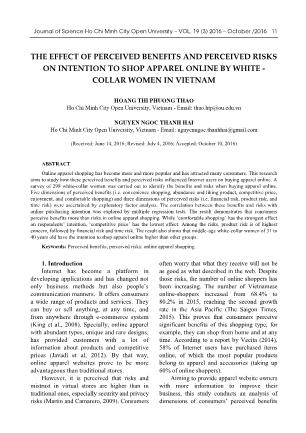
Journal of Science Ho Chi Minh City Open University – VOL. 19 (3) 2016 – October /2016 11 THE EFFECT OF PERCEIVED BENEFITS AND PERCEIVED RISKS ON INTENTION TO SHOP APPAREL ONLINE BY WHITE - COLLAR WOMEN IN VIETNAM HOANG THI PHUONG THAO Ho Chi Minh City Open University, Vietnam - Email: thao.htp@ou.edu.vn NGUYEN NGOC THANH HAI Ho Chi Minh City Open University, Vietnam - Email: nguyenngoc.thanhhai@gmail.com (Received: June 14, 2016; Revised: July 4, 2016; Accepted: October 10, 2016) ABSTRACT Online apparel shopping has become more and more popular and has attracted many consumers. This research aims to study how these perceived benefits and perceived risks influenced Internet users on buying apparel online. A survey of 298 white-collar women was carried out to identify the benefits and risks when buying apparel online. Five dimensions of perceived benefits (i.e. convenience shopping, abundance and liking product, competitive price, enjoyment, and comfortable shopping) and three dimensions of perceived risks (i.e. financial risk, product risk, and time risk) were ascertained by exploratory factor analysis. The correlation between these benefits and risks with online purchasing intention was explored by multiple regression tests. The result demonstrates that consumers perceive benefits more than risks in online apparel shopping. While ‘comfortable shopping’ has the strongest effect on respondents’ intention, ‘competitive price’ has the lowest effect. Among the risks, product risk is of highest concern, followed by financial risk and time risk. The result also shows that middle-age white-collar women of 31 to 40 years old have the intention to shop apparel online higher than other groups. Keywords: Perceived benefits; perceived risks; online apparel shopping. 1. Introduction Internet has become a platform in developing applications and has changed not only business methods but also people’s communication manners. It offers consumers a wide range of products and services. They can buy or sell anything, at any time, and from anywhere through e-commerce system (King et al., 2008). Specially, online apparel with abundant types, unique and rare designs, has provided customers with a lot of information about products and competitive prices (Javadi et al, 2012). By that way, online apparel websites prove to be more advantageous than traditional stores. However, it is perceived that risks and mistrust in virtual stores are higher than in traditional ones, especially security and privacy risks (Martin and Camarero, 2009). Consumers often worry that what they receive will not be as good as what described in the web. Despite those risks, the number of online shoppers has been increasing. The number of Vietnamese online-shoppers increased from 68.4% to 80.2% in 2015, reaching the second growth rate in the Asia Pacific (The Saigon Times, 2015). This proves that consumers perceive significant benefits of this shopping type; for example, they can shop from home and at any time. According to a report by Vecita (2014), 58% of Internet users have purchased items online, of which the most popular products belong to apparel and accessories (taking up 60% of online shoppers). Aiming to provide apparel website owners with more information to improve their business, this study conducts an analysis of dimensions of consumers’ perceived benefits 12 The effect of perceived benefits and perceived risks on intention to shop apparel... and risks and their effects on apparel shopping intention of Vietnamese white-collar women. 2. Literature review Shopping intention Shopping Intention is an important figure for monitoring and mearsuring in advertisement and marketing because brands want to spend money attracting market audience to use their product or service (Crespo, 2009). It is an anxious expression for buying a product or service in the future. Shopping intention is determined as a plan purchase products or services in the future from consumers who have not purchased that type of products or services yet (Martin and Camarero, 2009). Frosythe’s research (2006) proved that consumers who purchased online frequently and spent a lot of money for this channel perceived more benefits than risks. While Wani and Malik (2013) noted that consumers perceived risks higher than perceived benefits, especially in India. Therefore, it is interesting to find out what kinds of benefits and risks of online shopping the Vietnamese consumers concern most. Perceived benefits Benefit is a convenience or profit achieved from anything. Perceived benefit is a trust about positive result in reality or when under a threat (Oxford, 1089). Lim’s and Ting’s research (2012) showed that perceptions have affected significantly to attitude and online shopping intention of individuals. ... 0.691 FINR_22 Information of individual account may be disclosed. 3.61 0.664 0.760 FINR_23 Information of payment card of buyer may be disclosed. 3.28 0.538 0.745 FINR_24 Payment may not be returned if the product is not similar to what described. 3.85 0.985 0.725 Cronbach’s Alpha: 0.771 Overall means: 3.434 P ro d u ct R is k PROR_25 The size of apparel may not tally with international standards. 3.25 0.700 0.674 PROR_26 I cannot try on the apparel online. 3.42 0.754 0.665 PROR_27 I cannot touch and feel the apparel. 3.73 0.637 0.685 PROR_28 I cannot receive the apparel online in a few minutes. 3.49 0.735 0.688 PROR_29 When receiving apparel, product will not be similar to the apparel image I saw. 3.31 0.701 0.648 Cronbach’s Alpha: 0.720 Overall mean: 3.442 T im e R is k TIMR_30 Spending a lot of time learning how to order apparel online. 3.08 0.796 0.742 TIMR_31 Spending a lot of time searching the right products. 3.18 0.728 0.753 Journal of Science Ho Chi Minh City Open University – VOL. 19 (3) 2016 – October/2016 17 Dimension Code Item Item Statement Mean Std. Deviation Cronbach’s Alpha if deleted item TIMR_32 It takes too long for the product to be delivered. 3.64 0.810 0.755 TIMR_33 It takes too long to cancel an order. 3.15 0.785 0.771 TIMR_34 It takes too long to complete the procedures for returning a product. 3.44 0.747 0.755 TIMR_35 It takes too long to compare prices when shopping apparel online. 3.07 0.816 0.759 Cronbach’s Alpha: 0.788 Overall mean: 3.261 In te n ti o n t o s h o p a p p ar el o n li n e INTD_36 I like to shop apparel online. 2.95 0.439 0.694 INTD _37 I will purchase apparel in online stores more often than in traditional stores. 3.33 0.476 0.580 INTD _38 I will purchase apparel via the Internet in the near future. 3.15 0.427 0.603 INTD _39 I will learn how to purchase apparel online in the near future. 3.19 0.495 0.578 Cronbach’s Alpha: 0.683 Overall mean: 3.156 Exploratory factor analysis An exploratory factor analysis (EFA) is performed to evaluate the validity of the measurement scales of all variables included in the proposed model. Total 36 items are entered to analyze exploratory factor and include two parts. Part 1 consists of 32 items to present perceived benefits and risks in online shopping, and part 2 with 4 items describes white collar women’s intention to shop apparel online. The KMO of dimensions of perceived risks in part 1 is 0.808, and its Barlett’s test p-value is 0.000. The KMO of intention to shop apparel online in part 2 is 0.700, and its Barlett’s test p-value is 0.000. The test values indicate that the data are accepted to perform further factor analysis. Then in part 1, we use principal component analysis method and variable maximization rotation to maintain 32 items. Their factor loadings are shown in Table 4. The table shows eight common factors extracted from the remaining 32 items. Cumulative extraction sum of squared loading is 57.111%. All factor loadings are above 0.5 and no-cross construct loadings are above 0.3, indicating good validity of discrimination. These eight variables can be used for multiple regression tests. In part 2, we also get one common factor and the cumulative extraction sums of squared loading are 51.571% as shown in Table 4. 18 The effect of perceived benefits and perceived risks on intention to shop apparel... Table 4 Factor analysis Variable Item Code Factor loading Cumulative extraction sums of squared loading Time risk TIMR _31 0.727 17.253% TIMR _32 0.590 TIMR _33 0.667 TIMR _34 0.581 TIMR _35 0.657 TIMR _36 0.609 Financial Risk FINR _21 0.675 13.123% FINR _22 0.763 FINR _23 0.534 FINR _24 0.703 FINR _25 0.727 Product Risk PROR _26 0.561 5.779% PROR _27 0.611 PROR _28 0.556 PROR _29 0.697 PROR _30 0.698 Abundance and liking Product PROD _06 0.703 4.857% PROD _07 0.791 PROD _08 0.756 Enjoyment ENJY _18 0.725 4.451% ENJY _19 0.679 ENJY _20 0.620 Competitive Price PRIC _10 0.785 4.112% PRIC _11 0.705 PRIC _12 0.750 Convenience Shopping CONV _01 0.639 3.956% CONV _02 0.641 CONV _03 0.670 CONV _04 0.698 Journal of Science Ho Chi Minh City Open University – VOL. 19 (3) 2016 – October/2016 19 Variable Item Code Factor loading Cumulative extraction sums of squared loading Comfortable Shopping COMF _14 0.537 3.579% COMF _15 0.730 COMF _16 0.788 Intending to shop apparel online INT _37 0.565 51.571% INT _38 0.766 INT _39 0.749 INT _40 0.772 Linear regression analysis In Table 5, five factors belonging to perceived benefits have standardized beta coefficients greater than zero with their significance less than 0.01. This means these factors have positively affected on intention to shop apparel online so an increase of these perceived benefits will help enhance intention to shop apparel online. On the contrary, three standardized beta coefficients of perceived risks are less than zero with their significance less than 0.01. These factors have affected the dependent variable negatively. This means the more these three perceived risks increase, the less intention to shop apparel online decreases. The VIF of each independent variable in the regression model is lower than 2, which meets the criteria of multicollinearity testing (Hair et al., 2010). In other words, there is no multicollinearity in the regression model. Table 5 Linear regression Independent Variable Standardized Beta Coefficients Sig. VIF Convenience shopping 0.234 0.000 1.309 Abundance and diversify of product 0.225 0.000 1.244 Competitive price 0.151 0.000 1.275 Comfortable shopping 0.270 0.000 1.205 Enjoyment 0.157 0.000 1.310 Financial risk -0.208 0.000 1.483 Product risk -0.263 0.000 1.572 Time risk -0.182 0.000 1.727 Adjusted R Square = 0.770 Sig. F = 0.000 Durbin Watson = 2.114 20 The effect of perceived benefits and perceived risks on intention to shop apparel... The adjusted R square in the regression model is 0.770, which means that 77% variation of white collar women’s intention to shop apparel online is explained by variation of 8 factors: convenience shopping, abundance and diversify of products, competitive price, enjoyment, comfortable shopping, financial risk, product risk and time risk. For perceived benefits, comfortable shopping has the strongest effect on online shopping intention (β = 0.270) followed by convenience shopping (β =0.234), abundance and liking of products (β = 0.225), and enjoyment (β = 0.157) and competitive price (β = 0.151). For perceived risks, product risk has the highest effect (β = -0.263), followed by financial risk (β =-0.208), and time risk (β = - 0.182). Thus, eight hypotheses are accepted. ANOVA test of different age groups This study continues exploring difference among age groups of white-collar female and their intention to shop apparel online. White- collar female’s ages are divided into three groups: 22-30, 31-40, 41-50. The result of ANOVA test is showed in Table 6. Table 6 Result of one-way ANOVA analysis (I) (J) N Means Mean Difference (I – J) Sig. 22 – 30 31 – 40 41 – 50 98 3.1327 -0,2008* 0,1053 0,035 0,126 31 – 40 22 – 30 41 – 50 136 3.3335 0,2008* 0,3062* 0,035 0,000 41 – 50 22 – 30 31 – 40 64 3.0273 -0,1053 -0,3062* 0,126 0,000 Ages of respondents really affect their intentions. The intention of women in 31- 40 age group is significantly different from that of women in 41- 50 age group and women in 22- 30 age group. The greatest intention belongs to women of 31-40 age group (mean =3.33), followed by 22-30 age group (mean =3.13), and 41-50 age group (mean =3.03). In brief, all eight hypotheses are supported, of which 5 hypotheses shows the positive correlation between perceived benefits and shopping intention and 3 hypotheses show the negative correlation between perceived risks and shopping intention. The degree effect of each benefit and risk on white collar women’s intention to shop apparel online is different. The age group of 31-40 has strongest intention to buy apparel online. 6. Conclusion and future directions Conclusion This study determines that there are five dimensions of white-collar women’s perceived benefits and three dimensions of their perceived risks when they consider shopping apparel online. All eight dimensions give good explanations about the benefits and risks when shopping online. Perceived benefits have positive influence, on the contrary, perceived risks have negative influence on white collar women’s intention to shop apparel online. Managers should concentrate on enhancing the benefits and reducing the risks to redouble competitive capacity of their websites and attract more customers, especially the main market segment of white-collar women from 31 to 40 Journal of Science Ho Chi Minh City Open University – VOL. 19 (3) 2016 – October/2016 21 years of age. Managers should improve selling process to make it easier and more convenient for customers. Furthermore, they need to advertise their websites widely to help customers recognize the convenience of shopping online. To enhance white-collar women to shop apparel online, managers should pay attention to product’s factors by diversifying product styles. More focus should be put on fashionable tendency by designing attractive interface with understandable navigation to make customers comfortable and save time in their search for favorite items. Website design should be friendly to help consumers stay longer in the site and get more shopping experience. Information about product characteristics and related services should be continuously updated and truthful to build customer’s trust of e-retailer. Online price of apparel should be lower than that of physical stores to attract more women to purchase apparel online. Women often consider product’s price before purchasing. They also tend to compare prices among known brands so competitive price is a key to attract white-collar women to do more shopping. Return policy, i.e. allowing customers return apparel in suitable time, and guiding them to physical place to try out and select the most suitable one, will contribute to establish website’s reliability. Addition to applying modern payment methods like credit cards, debit cards, and e-wallet, managers should maintain COD delivery system because the white-collar women want to touch apparel before they pay. Hotline and chat room of customer services should be operated effectively to relieve consumers’ perceived risks. Future direction Our study provides a new measurement of perceived benefits and risks dimensions which influence on the intent to shopping apparel online of Vietnamese white-collar women. This study sets some foundation for further research on online shopping intention with other investigated objects and other online products because specific products and objects will have different perceived benefits and risks. At the same time, a future additional proposition of our study lies at considering a correlation between consumers’ purchasable intention and real purchasing behavior. Moreover, future studies can perform larger sample size and choose appropriate sampling to gain higher generalizability References Azura, Z. (2010). The Influence of the Intention Online Purchase Among University Kuala Lumpur, Malaysian Institute of Information Technology Lecturer’s and Staff’s. Unpublished Final Year Project, Malaysian Institute of Information Technology, University of Kuala Lumpur, Malaysia. Alreck, P. and Settle, R. (2002). The hurried consumer: time-saving perceptions of internet and catalogue shopping. Journal of Database Marketing, 10(1), 25-35. Barnes, S.J., Bauer, H.H., Neumann, M.M. and Huber, F. (2007). Segmenting cyberspace: a customer typology for the Internet. European Journal of Marketing, 41(1/2), 71-93. Chan, I.W., Ling, L.H, Ying L.H., Hiang, T.S. and Kuan, T.S. (2012). Relationship between perceived benefits and undergraduates’ online shopping decisions in Malaysia, Universiti Tunku Abdul Rahman. Crespo A.H., Bosque, I.E. and Sánchez, M.G.S. (2009). The influence of perceived risk on Internet shopping behavior: a multidimensional perspective. Journal of Risk Research, 12(2), 259-277. Delafrooz and Narges (2009). Factors Affecting Students' Online Shopping Attitude and Purchase Intention, PhD thesis, Universiti Putra Malaysia. [Online]. Available: [2013, July 20]. 22 The effect of perceived benefits and perceived risks on intention to shop apparel... Forsythe, S., Liu, C., Shannon, D. and Gardner L.C. (2006). Development of a scale to measure the perceived benefits and risks of online shopping. Journal of Interactive Marketing, 20(2), 55-75. Hair, J.F., Black, W.C., Babin, B.J., & Anderson, R.E. (2010). Multivariate Data Analysis. Seventh Edition. Prentice Hall, Upper Saddle River, New Jersey. Hoffman, D., Novak, T., and Peralta, M. (1999). Building consumer trust online. Commun. ACM, 42(4), 80–85. Javadi, M.H.M., Dolatabadi, H. R., Nourbakhsh, M., Poursaeedi, A. and Asadollahi, A. R. (2012). An Analysis of Factors Affecting on Online Shopping Behavior of Consumers. International Journal of Marketing Studies, 4(5), 81-98. Lim, W.M and Ting, D.H. (2012). E-shopping: an Analysis of the Technology Acceptance Model. Modern Applied Science, 6(4), 24-50. Martin, S. and Camarero, C. (2009). How perceived risk affects online buying. Online Information Review, 33(4), 629-654. Nguyen Thi Bao Chau and Le Nguyen Xuan Dao (2013). Phân tích các nhân tố ảnh hưởng đến hành vi mua sắm trực tuyến của người tiêu dùng thành phố Cần Thơ. Tạp chí khoa học trường Đại học Cần Thơ, phần D: Khoa học Chính trị , Kinh tế và Pháp luật: 30. Oxford (1989). Oxford English Dictionary. Oxford University Press, 2 nd edition. Thesaigontimes (2015). Mastercard: mua sắm trực tuyến ở Việt Nam tăng nhanh thứ hai Châu Á-Thái Bình Dương. < TBD.html>, accessed June 28, 2015. Vecita (2015). Báo cáo thương mại điện tử Việt Nam năm 2014. <http:// www.vecita.gov.vn/anpham/230/Bao-cao- Thuong-mai-dien-tu-Viet-Nam-nam-2014>, ngày truy cập 20/03/2015. Wani, S.N. and Malik, S. (2013). A Comparative Study of Online Shopping Behaviour: Effects of Perceived Risks and Benefits. International Journal of Marketing and Business Communication.
File đính kèm:
 the_effect_of_perceived_benefits_and_perceived_risks_on_inte.pdf
the_effect_of_perceived_benefits_and_perceived_risks_on_inte.pdf

